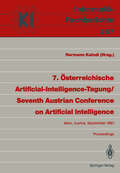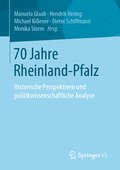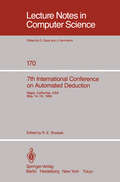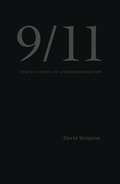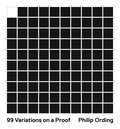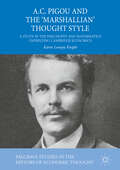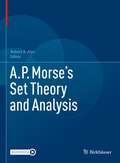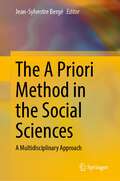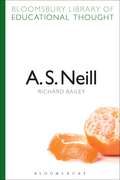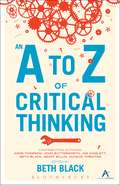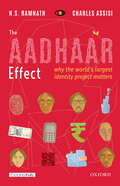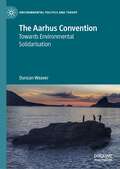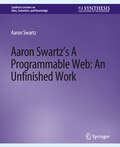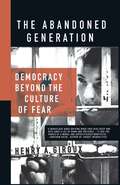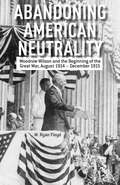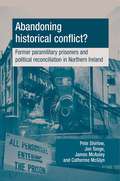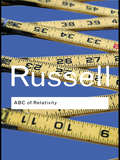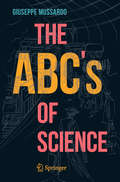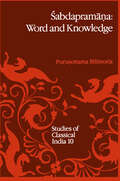- Table View
- List View
7. Österreichische Artificial-Intelligence-Tagung / Seventh Austrian Conference on Artificial Intelligence: Wien, Austria, 24.–27. September 1991 Proceedings (Informatik-Fachberichte #287)
by Hermann Kaindl70 Jahre Rheinland-Pfalz: Historische Perspektiven und politikwissenschaftliche Analyse
Im Jahr 1947 wurde Rheinland-Pfalz als Land neu gegründet. Dabei war ungewiss, wie sich dieses Gebilde aus ehemals preußischen, hessischen und bayerischen Teilen entwickeln würde. 70 Jahre nach der Landesgründung blickt dieser Band auf die Regierungsperioden sowie wichtige Etappen und Schwerpunkte der Landespolitik zurück. Auch ausgewählte Aspekte des Regierungssystems werden beleuchtet. Mehr als 20 Beiträge verbinden dabei historische und politikwissenschaftliche Perspektiven auf zeitgeschichtliche, aber auch aktuelle Entwicklungen.
7th International Conference on Automated Deduction: Proceedings (Lecture Notes in Computer Science #170)
by R. E. ShostakThe Seventh International Conference on Automated Deduction was held May 14-16, 19S4, in Napa, California. The conference is the primary forum for reporting research in all aspects of automated deduction, including the design, implementation, and applications of theorem-proving systems, knowledge representation and retrieval, program verification, logic programming, formal specification, program synthesis, and related areas. The presented papers include 27 selected by the program committee, an invited keynote address by Jorg Siekmann, and an invited banquet address by Patrick Suppes. Contributions were presented by authors from Canada, France, Spain, the United Kingdom , the United States, and West Germany. The first conference in this series was held a decade earlier in Argonne, Illinois. Following the Argonne conference were meetings in Oberwolfach, West Germany (1976), Cambridge, Massachusetts (1977), Austin, Texas (1979), Les Arcs, France (19S0), and New York, New York (19S2). Program Committee P. Andrews (CMU) W.W. Bledsoe (U. Texas) past chairman L. Henschen (Northwestern) G. Huet (INRIA) D. Loveland (Duke) past chairman R. Milner (Edinburgh) R. Overbeek (Argonne) T. Pietrzykowski (Acadia) D. Plaisted (U. Illinois) V. Pratt (Stanford) R. Shostak (SRI) chairman J. Siekmann (U. Kaiserslautern) R. Waldinger (SRI) Local Arrangements R. Schwartz (SRI) iv CONTENTS Monday Morning Universal Unification (Keynote Address) Jorg H. Siekmann (FRG) .
9/11: The Culture Of Commemoration
by David SimpsonAfter the terrorist attacks of September 11, 2001, a general sense that the world was different-that nothing would ever be the same-settled upon a grieving nation; the events of that day were received as cataclysmic disruptions of an ordered world. Refuting this claim, David Simpson examines the complex and paradoxical character of American public discourse since that September morning, considering the ways the event has been aestheticized, exploited, and appropriated, while "Ground Zero" remains the contested site of an effort at adequate commemoration. In 9/11, Simpson argues that elements of the conventional culture of mourning and remembrance-grieving the dead, summarizing their lives in obituaries, and erecting monuments in their memory-have been co-opted for political advantage. He also confronts those who labeled the event an "apocalypse," condemning their exploitation of 9/11 for the defense of torture and war. In four elegant chapters-two of which expand on essays originally published in the London Review of Books to great acclaim-Simpson analyzes the response to 9/11: the nationally syndicated "Portraits of Grief" obituaries in the New York Times; the debates over the rebuilding of the World Trade Center towers and the memorial design; the representation of American and Iraqi dead after the invasion of March 2003, along with the worldwide circulation of the Abu Ghraib torture photographs; and the urgent and largely ignored critique of homeland rhetoric from the domain of critical theory. Calling for a sustained cultural and theoretical analysis, 9/11 is the first book of its kind to consider the events of that tragic day with a perspective so firmly grounded in the humanities and so persuasive about the contribution they can make to our understanding of its consequences.
9/11: The Culture Of Commemoration
by David SimpsonAfter the terrorist attacks of September 11, 2001, a general sense that the world was different-that nothing would ever be the same-settled upon a grieving nation; the events of that day were received as cataclysmic disruptions of an ordered world. Refuting this claim, David Simpson examines the complex and paradoxical character of American public discourse since that September morning, considering the ways the event has been aestheticized, exploited, and appropriated, while "Ground Zero" remains the contested site of an effort at adequate commemoration. In 9/11, Simpson argues that elements of the conventional culture of mourning and remembrance-grieving the dead, summarizing their lives in obituaries, and erecting monuments in their memory-have been co-opted for political advantage. He also confronts those who labeled the event an "apocalypse," condemning their exploitation of 9/11 for the defense of torture and war. In four elegant chapters-two of which expand on essays originally published in the London Review of Books to great acclaim-Simpson analyzes the response to 9/11: the nationally syndicated "Portraits of Grief" obituaries in the New York Times; the debates over the rebuilding of the World Trade Center towers and the memorial design; the representation of American and Iraqi dead after the invasion of March 2003, along with the worldwide circulation of the Abu Ghraib torture photographs; and the urgent and largely ignored critique of homeland rhetoric from the domain of critical theory. Calling for a sustained cultural and theoretical analysis, 9/11 is the first book of its kind to consider the events of that tragic day with a perspective so firmly grounded in the humanities and so persuasive about the contribution they can make to our understanding of its consequences.
99 Variations on a Proof
by Philip OrdingAn exploration of mathematical style through 99 different proofs of the same theoremThis book offers a multifaceted perspective on mathematics by demonstrating 99 different proofs of the same theorem. Each chapter solves an otherwise unremarkable equation in distinct historical, formal, and imaginative styles that range from Medieval, Topological, and Doggerel to Chromatic, Electrostatic, and Psychedelic. With a rare blend of humor and scholarly aplomb, Philip Ording weaves these variations into an accessible and wide-ranging narrative on the nature and practice of mathematics.Inspired by the experiments of the Paris-based writing group known as the Oulipo—whose members included Raymond Queneau, Italo Calvino, and Marcel Duchamp—Ording explores new ways to examine the aesthetic possibilities of mathematical activity. 99 Variations on a Proof is a mathematical take on Queneau’s Exercises in Style, a collection of 99 retellings of the same story, and it draws unexpected connections to everything from mysticism and technology to architecture and sign language. Through diagrams, found material, and other imagery, Ording illustrates the flexibility and creative potential of mathematics despite its reputation for precision and rigor.Readers will gain not only a bird’s-eye view of the discipline and its major branches but also new insights into its historical, philosophical, and cultural nuances. Readers, no matter their level of expertise, will discover in these proofs and accompanying commentary surprising new aspects of the mathematical landscape.
99 Variations on a Proof
by Philip OrdingAn exploration of mathematical style through 99 different proofs of the same theoremThis book offers a multifaceted perspective on mathematics by demonstrating 99 different proofs of the same theorem. Each chapter solves an otherwise unremarkable equation in distinct historical, formal, and imaginative styles that range from Medieval, Topological, and Doggerel to Chromatic, Electrostatic, and Psychedelic. With a rare blend of humor and scholarly aplomb, Philip Ording weaves these variations into an accessible and wide-ranging narrative on the nature and practice of mathematics.Inspired by the experiments of the Paris-based writing group known as the Oulipo—whose members included Raymond Queneau, Italo Calvino, and Marcel Duchamp—Ording explores new ways to examine the aesthetic possibilities of mathematical activity. 99 Variations on a Proof is a mathematical take on Queneau’s Exercises in Style, a collection of 99 retellings of the same story, and it draws unexpected connections to everything from mysticism and technology to architecture and sign language. Through diagrams, found material, and other imagery, Ording illustrates the flexibility and creative potential of mathematics despite its reputation for precision and rigor.Readers will gain not only a bird’s-eye view of the discipline and its major branches but also new insights into its historical, philosophical, and cultural nuances. Readers, no matter their level of expertise, will discover in these proofs and accompanying commentary surprising new aspects of the mathematical landscape.
A.C. Pigou and the 'Marshallian' Thought Style: A Study in the Philosophy and Mathematics Underlying Cambridge Economics (Palgrave Studies in the History of Economic Thought)
by Karen Lovejoy KnightThis book provides a study of the forces underlying the development of economic thought at Cambridge University during the late nineteenth century and the first half of the twentieth century. The primary lens it uses to do so is an examination of how Arthur Cecil Pigou’s thinking, heavily influenced by his predecessor, Alfred Marshall, evolved.Aspects of Pigou’s context, biography and philosophical grounding are reconstructed and then situated within the framework of Ludwik Fleck’s philosophy of scientific knowledge, most notably by drawing on the notions of ‘thought styles’ and ‘thought collectives’. In this way, Knight provides a novel contribution to the history of Pigou's economic thought.
A.P. Morse’s Set Theory and Analysis
This volume explores A.P. Morse’s (1911-1984) development of a formal language for writing mathematics, his application of that language in set theory and mathematical analysis, and his unique perspective on mathematics. The editor brings together a variety of Morse’s works in this compilation, including Morse's book A Theory of Sets, Second Edition (1986), in addition to material from another of Morse’s publications, Web Derivatives, and notes for a course on analysis from the early 1950's. Because Morse provided very little in the way of explanation in his written works, the editor’s commentary serves to outline Morse’s goals, give informal explanations of Morse’s formal language, and compare Morse’s often unique approaches to more traditional approaches. Minor corrections to Morse’s previously published works have also been incorporated into the text, including some updated axioms, theorems, and definitions. The editor’s introduction thoroughly details the corrections and changes made and provides readers with valuable insight on Morse’s methods.A.P. Morse’s Set Theory and Analysis will appeal to graduate students and researchers interested in set theory and analysis who also have an interest in logic. Readers with a particular interest in Morse’s unique perspective and in the history of mathematics will also find this book to be of interest.
The A Priori Method in the Social Sciences: A Multidisciplinary Approach
by Jean-Sylvestre BergéThis edited volume takes a multidisciplinary look at the philosophical concept of a priori. Placing social sciences at the heart of the discussion, this book establishes a dialogue between various disciplines and the different postulates, presuppositions, prejudices, paradigms, beliefs, commonplaces, biases or emotions that forge their theoretical and practical constructs. The book is divided into three parts. Chapters in Part I lay the foundations of a new antecedent approach that revisits the classical approach to a priori and its relationships with law and philosophy. Chapters in Part II extend the analysis to economics and management, on such key topics as blockchain technology, labor, health insurance and innovation. Finally, chapters in Part III turn to anthropology and sociology, to reconsider the core methods of these different disciplines and to nourish reflection on the basis of new working hypotheses.
A. S. Neill (Bloomsbury Library of Educational Thought)
by Richard BaileyA. S. Neill was probably the most famous school teacher of the twentieth century. His school, Summerhill, founded in 1921, attracted admiration and criticism from around the world, and became an emblem of radical school reform and child-centred education. Neill claimed that he was a practical man, but this book reveals that Summerhill expresses a comprehensive and distinctive set of ideas. Whether he wanted to be or not, Neill was an important educational thinker with a powerful influence on current educational approaches and philosophy.A. S. Neill is the first book to examine this philosophy of education in detail. It begins by showing how Neill's fascinating life story gives clues to the origin of his ideas, and why they mattered so much to him. It goes on to explore the main themes of his philosophy, showing how they relate to the work of other great educational thinkers, and how they are novel. It also discusses whether there are lessons that could and should be learned by other schools from the original, alternative 'free' school of Summerhill.
A. S. Neill (Bloomsbury Library of Educational Thought)
by Richard BaileyA. S. Neill was probably the most famous school teacher of the twentieth century. His school, Summerhill, founded in 1921, attracted admiration and criticism from around the world, and became an emblem of radical school reform and child-centred education. Neill claimed that he was a practical man, but this book reveals that Summerhill expresses a comprehensive and distinctive set of ideas. Whether he wanted to be or not, Neill was an important educational thinker with a powerful influence on current educational approaches and philosophy.A. S. Neill is the first book to examine this philosophy of education in detail. It begins by showing how Neill's fascinating life story gives clues to the origin of his ideas, and why they mattered so much to him. It goes on to explore the main themes of his philosophy, showing how they relate to the work of other great educational thinkers, and how they are novel. It also discusses whether there are lessons that could and should be learned by other schools from the original, alternative 'free' school of Summerhill.
An A to Z of Critical Thinking
by Beth BlackCritical thinking is becoming increasingly prominent as an academic discipline taught and examined in schools and universities, as well as a crucial skill for everyday life. To be a successful critical thinker it is vital to understand how the different concepts and terms are defined and used. The terminology often presents a stumbling block for the beginner, since much of it is used imprecisely in everyday language. This definitive A to Z guide provides precise definitions for over 130 terms and concepts used in critical thinking. Each entry presents a short definition followed by a more detailed explanation and authoritative clarification. Armed with the tools and knowledge provided in these pages, the reader will be able to distinguish an assertion from an argument, a flaw from a fallacy, a correlation from a cause and a fact from an opinion. The book is an invaluable resource for teachers and students of critical thinking, providing all the tools necessary to effectively analyse, evaluate, question and reason for yourself.
An A to Z of Critical Thinking
by Beth BlackCritical thinking is becoming increasingly prominent as an academic discipline taught and examined in schools and universities, as well as a crucial skill for everyday life. To be a successful critical thinker it is vital to understand how the different concepts and terms are defined and used. The terminology often presents a stumbling block for the beginner, since much of it is used imprecisely in everyday language. This definitive A to Z guide provides precise definitions for over 130 terms and concepts used in critical thinking. Each entry presents a short definition followed by a more detailed explanation and authoritative clarification. Armed with the tools and knowledge provided in these pages, the reader will be able to distinguish an assertion from an argument, a flaw from a fallacy, a correlation from a cause and a fact from an opinion. The book is an invaluable resource for teachers and students of critical thinking, providing all the tools necessary to effectively analyse, evaluate, question and reason for yourself.
The Aadhaar Effect: Why the World’s Largest Identity Project Matters
by N.S. Ramnath Charles AssisiIdentification vs profiling; state welfare vs state surveillance; privacy vs transparency—Aadhaar has bitterly polarized India since its launch in 2010. No other project has captured the imagination of the people—or inspired such awe and anxiety—in recent memory. Aadhaar began life with a singular mandate: offer an identity to those Indian residents who didn’t have any. Along the way, it evolved into the welfare state’s flagship technology and altered forever how government, business, and society interact. The Aadhaar Effect is the story of the visionaries—bureaucrats, technologists, activists—who created or challenged India’s biggest juggernaut. It is equally the story of humans conflicted about complex choices that may make the world a better place. Polestar award winners N.S. Ramnath and Charles Assisi dive deep into the 12-digit number that has touched 1.2 billion lives and counting—and in the bargain, made the world sit up and take note of India’s ambition.
The Aarhus Convention: Towards Environmental Solidarisation (Environmental Politics and Theory)
by Duncan WeaverThe Aarhus Convention on access to information, public participation in decision-making and access to justice in environmental matters has been celebrated as a pioneering international environmental agreement. Given that a quarter-century has passed since Aarhus was opened for signature, now is an opportune moment to revisit it from a fresh perspective. Marking this anniversary, this book explores Aarhus from the vista of the English School of International Relations, an ethically-minded perspective used to gauge the prevalence of state-oriented and human-oriented progress from the Convention's rationales and realities. It firstly considers Aarhus' propagation, investigating the legal, diplomatic and geopolitical contexts enabling its emergence. It secondly investigates Aarhus' germination, with reference to its trinity of procedural rights. Thirdly, the book examines the Convention's growth, in terms of the development of its organisational infrastructure. The chief finding is that Aarhus demonstrates, in environmental contexts, the feasibility and benefit of fostering 'humankind' solidarist progress, rooted in moral cosmopolitanism, within the existing power arrangements of a sovereignty-based pluralism. Pluralist concerns for diversity and international order are found to be a precondition for more ethically ambitious solidarist endeavours. These observations reinforce the logic of solidarisation, an English School innovation that presents sovereignty as (a) being ethically matured by solidarism whilst (b) delimiting solidarism within the threshold of states' tolerance.
Aaron Swartz's The Programmable Web: An Unfinished Work (Synthesis Lectures on Data, Semantics, and Knowledge)
by Aaron SwartzThis short work is the first draft of a book manuscript by Aaron Swartz written for the series "Synthesis Lectures on the Semantic Web" at the invitation of its editor, James Hendler. Unfortunately, the book wasn't completed before Aaron's death in January 2013. As a tribute, the editor and publisher are publishing the work digitally without cost. From the author's introduction: " . . . we will begin by trying to understand the architecture of the Web -- what it got right and, occasionally, what it got wrong, but most importantly why it is the way it is. We will learn how it allows both users and search engines to co-exist peacefully while supporting everything from photo-sharing to financial transactions. We will continue by considering what it means to build a program on top of the Web -- how to write software that both fairly serves its immediate users as well as the developers who want to build on top of it. Too often, an API is bolted on top of an existing application, as an afterthought or a completely separate piece. But, as we'll see, when a web application is designed properly, APIs naturally grow out of it and require little effort to maintain. Then we'll look into what it means for your application to be not just another tool for people and software to use, but part of the ecology -- a section of the programmable web. This means exposing your data to be queried and copied and integrated, even without explicit permission, into the larger software ecosystem, while protecting users' freedom. Finally, we'll close with a discussion of that much-maligned phrase, 'the Semantic Web,' and try to understand what it would really mean."
The Abandoned Generation: Democracy Beyond the Culture of Fear
by H. GirouxHenry Giroux continues his critique of American culture and the way it impinges on the lives of our children. This time, Henry goes further, looking at the 'Bush Restoration' years, the attacks of September 11th and the way the world has been transformed for our children and young adults.
Abandoning American Neutrality: Woodrow Wilson and the Beginning of the Great War, August 1914 – December 1915
by R. FloydDuring the first 18 months of World War I, Woodrow Wilson sought to maintain American neutrality, but as this carefully argued study shows, it was ultimately an unsustainable stance. The tension between Wilson's idealism and pragmatism ultimately drove him to abandon neutrality, paving the way for America's entrance into the war in 1917.
Abandoning historical conflict?: Former political prisoners and reconciliation in Northern Ireland (PDF)
by Peter Shirlow Catherine Mcglynn James Mcauley Jon TongeDrawing on over 150 interviews with former IRA, INLA, UVF and UFF prisoners, this is a major analysis of why Northern Ireland has seen a transition from war to peace. Most accounts of the peace process are ‘top-down’, relying upon the views of political elites. This book is ‘bottom-up’, analysing the voices of those who actually ‘fought the war’. What made them fight, why did they stop and what are the lessons for other conflict zones? Using unrivalled access to members of the armed groups, the book, available for the first time in paperback, offers a critical appraisal of one-dimensional accounts of the onset of peace, grounded in ‘mutually hurting stalemate’ and ‘ripeness’, which downgrade the political and economic aspects of conflict. Military stalemate had been evident since the early 1970s and offers little in explaining the timing of the peace process. Moreover, republicans and loyalists based their ceasefires upon very different perceptions of transformation or victory. Based on a Leverhulme Trust project and written by an expert team, Abandoning Conflict offers a new analysis, based on subtle interplays of military, political, economic and personal changes and experiences.
Abandoning historical conflict?: Former political prisoners and reconciliation in Northern Ireland
by Peter Shirlow Catherine Mcglynn James Mcauley Jon TongeDrawing on over 150 interviews with former IRA, INLA, UVF and UFF prisoners, this is a major analysis of why Northern Ireland has seen a transition from war to peace. Most accounts of the peace process are ‘top-down’, relying upon the views of political elites. This book is ‘bottom-up’, analysing the voices of those who actually ‘fought the war’. What made them fight, why did they stop and what are the lessons for other conflict zones? Using unrivalled access to members of the armed groups, the book, available for the first time in paperback, offers a critical appraisal of one-dimensional accounts of the onset of peace, grounded in ‘mutually hurting stalemate’ and ‘ripeness’, which downgrade the political and economic aspects of conflict. Military stalemate had been evident since the early 1970s and offers little in explaining the timing of the peace process. Moreover, republicans and loyalists based their ceasefires upon very different perceptions of transformation or victory. Based on a Leverhulme Trust project and written by an expert team, Abandoning Conflict offers a new analysis, based on subtle interplays of military, political, economic and personal changes and experiences.
ABC of Relativity
by Bertrand RussellFirst published in 1925, Bertrand Russell’s ABC of Relativity was considered a masterwork of its time, contributing significantly to the mass popularisation of science. Authoritative and accessible, it provides a remarkable introductory guide to Einstein’s theory of Relativity to a general readership. One of the most definitive reference guides of its kind, and written by one of the twentieth century’s most influential philosophers, ABC of Relativity continues to be as relevant today as it was on first publication.
ABC of Relativity
by Bertrand RussellFirst published in 1925, Bertrand Russell’s ABC of Relativity was considered a masterwork of its time, contributing significantly to the mass popularisation of science. Authoritative and accessible, it provides a remarkable introductory guide to Einstein’s theory of Relativity to a general readership. One of the most definitive reference guides of its kind, and written by one of the twentieth century’s most influential philosophers, ABC of Relativity continues to be as relevant today as it was on first publication.
The ABC’s of Science
by Giuseppe MussardoScience, with its inherent tension between the known and the unknown, is an inexhaustible mine of great stories. Collected here are twenty-six among the most enchanting tales, one for each letter of the alphabet: the main characters are scientists of the highest caliber most of whom, however, are unknown to the general public.This book goes from A to Z. The letter A stands for Abel, the great Norwegian mathematician, here involved in an elliptic thriller about a fundamental theorem of mathematics, while the letter Z refers to Absolute Zero, the ultimate and lowest temperature limit, - 273,15 degrees Celsius, a value that is tremendously cooler than the most remote corner of the Universe: the race to reach this final outpost of coldness is not yet complete, but, similarly to the history books of polar explorations at the beginning of the 20th century, its pages record successes, failures, fierce rivalries and tragic desperations. In between the A and the Z, the other letters of the alphabet are similar to the various stages of a very fascinating journey along the paths of science, a journey in the company of a very unique set of characters as eccentric and peculiar as those in Ulysses by James Joyce: the French astronomer who lost everything, even his mind, to chase the transits of Venus; the caustic Austrian scientist who, perfectly at ease with both the laws of psychoanalysis and quantum mechanics, revealed the hidden secrets of dreams and the periodic table of chemical elements; the young Indian astrophysicist who was the first to understand how a star dies, suffering the ferocious opposition of his mentor for this discovery. Or the Hungarian physicist who struggled with his melancholy in the shadows of the desert of Los Alamos; or the French scholar who was forced to hide her femininity behind a false identity so as to publish fundamental theorems on prime numbers. And so on and so forth.Twenty-six stories, which reveal the most authentic atmosphere of science and the lives of some of its main players: each story can be read in quite a short period of time -- basically the time it takes to get on and off the train between two metro stations. Largely independent from one another, these twenty-six stories make the book a harmonious polyphony of several voices: the reader can invent his/her own very personal order for the chapters simply by ordering the sequence of letters differently. For an elementary law of Mathematics, this can give rise to an astronomically large number of possible books -- all the same, but - then again - all different. This book is therefore the ideal companion for an infinite number of real or metaphoric journeys.
Śabdapramāṇa: A Doctrine in Mīmāṃsā-Nyāya Philosophy (with reference to Advaita Vedānta-paribhāṣā ‘Agama’) Towards a Framework for Ṡruti-prāmāṇya (Studies of Classical India #10)
by P.P. BilimoriaDr PurusQttama Bilimoria's book on sabdapramaIJa is an important one, and so is likely to arouse much controversy. I am pleased to be able to write a Foreword to this book, at a stage in my philosophical thinking when my own interests have been turning towards the thesis of sabdapramaIJa as the basis of Hindu religious and philosophical tradition. Dr Bilimoria offers many novel interpretations of classical Hindu theories about language, meaning, understanding and knowing. These interpretations draw upon the conceptual resources of contemporary analytic and phenomenological philosophies, without sacrificing the authentIcity that can arise only out of philologically grounded scholarship. He raises many issues, and claims to have resolved some of them. Certainly, he advances the overall discussion, and this is the best one could hope for in writing on a topic to which the best minds of antiquity and modern times have applied themselves. In this Foreword, I wish to focus on one of the issues which I have raised on earlier occasions, and on which Dr Bilimoria has several important things to say. The issue is: is sabdabodha eo ipso a linguistic knowing, i. e. , sabdapramll, or does Sabdabodha amount to knowing only when certain specifiable conditions are satisfied. It the second alternative be accepted, these additional conditions could not be the same as the familiar Ilsatti (contiguity), yogyata (semantic fitness), dka;,k~ll (expectancy) and tlltparya (intention), for these are, on the theory, conditions of sabdabodha itself.
